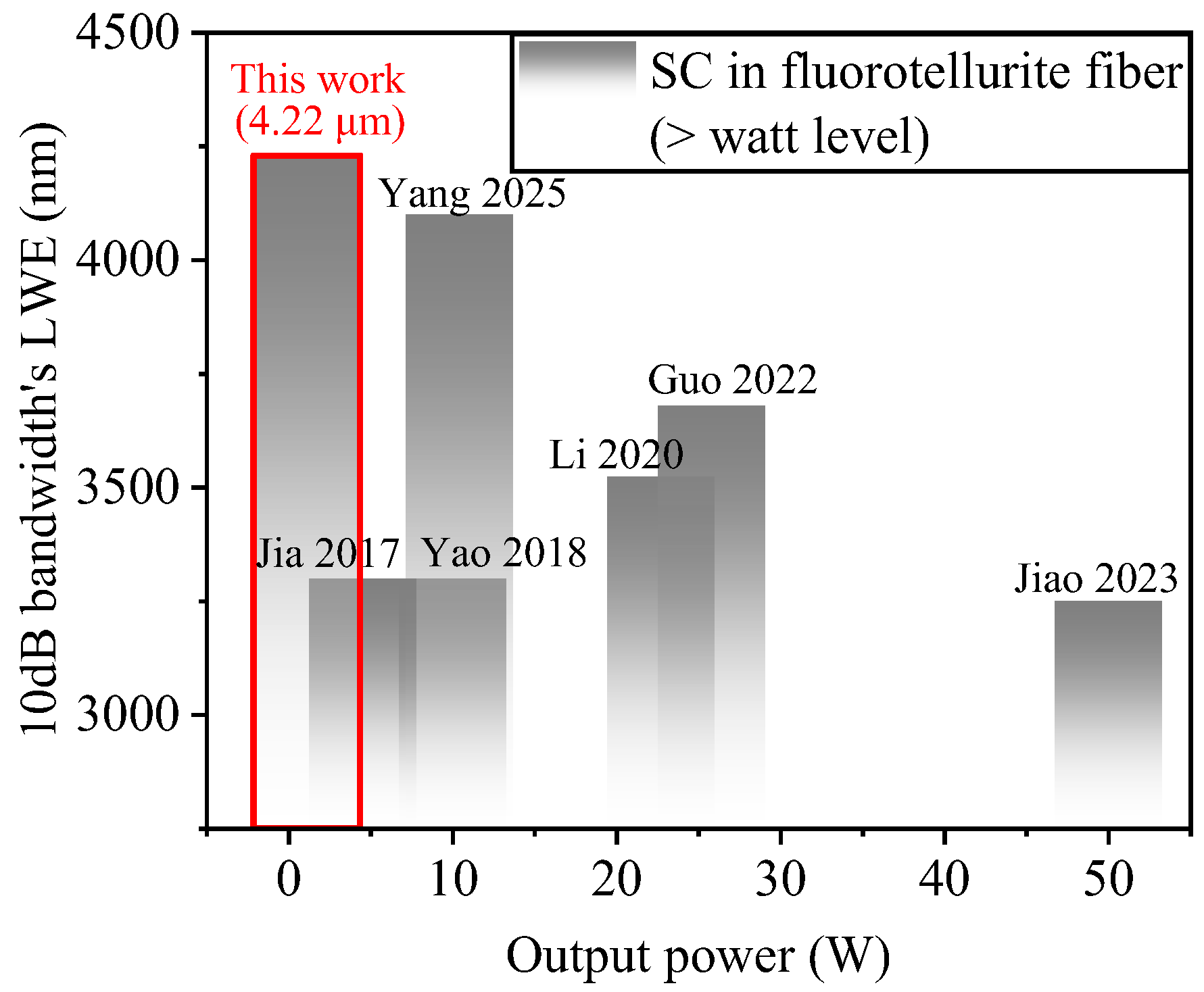Mid-Infrared Ultraflat Broadband Supercontinuum Generation with 10 dB Bandwidth of 2340 nm in a Tapered Fluorotellurite Fiber
Abstract
1. Introduction
2. Experiments and Results
3. Simulation and Discussions
4. Conclusions
Author Contributions
Funding
Institutional Review Board Statement
Informed Consent Statement
Data Availability Statement
Conflicts of Interest
References
- Gasser, C.; Kilgus, J.; Harasek, M.; Lendl, B.; Brandstetter, M. Enhanced mid-infrared multi-bounce ATR spectroscopy for online detection of hydrogen peroxide using a supercontinuum laser. Opt. Express 2018, 26, 12169–12179. [Google Scholar] [CrossRef] [PubMed]
- Ycas, G.; Giorgetta, F.R.; Baumann, E.; Coddington, I.; Herman, D.; Diddams, S.A.; Newbury, N.R. High-coherence mid-infrared dual-comb spectroscopy spanning 2.6 to 5.2 µm. Nat. Photonics 2018, 12, 202–208. [Google Scholar] [CrossRef]
- Timmers, H.; Kowligy, A.; Lind, A.; Cruz, F.C.; Nader, N.; Silfies, M.; Ycas, G.; Allison, T.K.; Schunemann, P.G.; Papp, S.B.; et al. Molecular fingerprinting with bright, broadband infrared frequency combs. Optica 2018, 5, 727–732. [Google Scholar] [CrossRef]
- Borondics, F.; Jossent, M.; Sandt, C.; Lavoute, L.; Gaponov, D.; Hideur, A.; Dumas, P.; Février, S. Supercontinuumbased Fourier transform infrared spectromicroscopy. Optica 2018, 5, 378–381. [Google Scholar] [CrossRef]
- Nallala, J.; Lloyd, G.R.; Kendall, C.; Shepherd, N.A.; Barr, H.; Stone, N. Identification of GI cancers utilizing rapid mid-infrared spectral imaging. Proc. SPIE 2016, 9703, 970303. [Google Scholar]
- Yang, W.; Zhang, B.; Xue, G.; Yin, K.; Hou, J. Thirteen watt all-fiber midinfrared supercontinuum generation in a single mode ZBLAN fiber pumped by a 2 µm MOPA system. Opt. Lett. 2014, 39, 1849–1852. [Google Scholar] [CrossRef]
- Yang, L.; Li, Y.; Zhang, B.; Wu, T.; Zhao, Y.; Hou, J. 30-W supercontinuum generation based on ZBLAN fiber in an all-fiber configuration. Photonics Res. 2019, 7, 1061–1065. [Google Scholar] [CrossRef]
- Zheng, Z.J.; Ouyang, D.Q.; Zhao, J.Q.; Liu, M.Q.; Ruan, S.C.; Yan, P.G.; Wang, J.Z. Scaling all-fiber mid-infrared supercontinuum up to 10 W-level based on thermal-spliced silica fiber and ZBLAN fiber. Photonics Res. 2016, 4, 135–139. [Google Scholar] [CrossRef]
- Shi, H.; Feng, X.; Tan, F.; Wang, P.; Wang, P. Multi-watt mid-infrared supercontinuum generated from a dehydrated large-core tellurite glass fiber. Opt. Mater. Express 2016, 6, 3967–3976. [Google Scholar] [CrossRef]
- Xia, C.; Xu, Z.; Islam, M.N.; Terry, F.L.; Freeman, M.J.; Zakel, A.; Mauricio, J. 10.5 W time-averaged power mid-IR supercontinuum generation extending beyond 4 µm with direct pulse pattern modulation. IEEE J. Sel. Top. Quantum Electron. 2009, 15, 422–434. [Google Scholar] [CrossRef]
- Kedenburg, S.; Strutynski, C.; Kibler, B.; Froidevaux, P.; Désévédavy, F.; Gadret, G.; Jules, J.; Steinle, T.; Mörz, F.; Steimnann, A.; et al. High repetition rate mid-infrared supercontinuum generation from 1.3 to 5.3 µm in robust step-index tellurite fibers. J. Opt. Soc. Am. B 2017, 34, 601–607. [Google Scholar] [CrossRef]
- Thapa, R.; Rhonehouse, D.; Nguyen, D.; Wiersma, K.; Smith, C.; Zong, J.; Chavez-Pirson, A. Mid-IR supercontinuum generation in ultra-low loss, dispersion-zero shifted tellurite glass fiber with extended coverage beyond 4.5 µm. Proc. SPIE 2013, 8898, 889808. [Google Scholar]
- Li, Z.R.; Jia, Z.X.; Yao, C.F.; Zhao, Z.P.; Li, N.; Hu, M.L.; Ohishi, Y.; Qin, W.P.; Qin, G.S. 22.7 W mid-infrared supercontinuum generation in fluorotellurite fibers. Opt. Lett. 2020, 45, 1882–1885. [Google Scholar] [CrossRef] [PubMed]
- Guo, X.H.; Jia, Z.X.; Jiao, Y.D.; Li, Z.R.; Yao, C.F.; Hu, M.L.; Ohishi, Y.; Qin, W.P.; Qin, G.S. 25.8 W all-fiber mid-infrared supercontinuum light sources based on fluorotellurite fibers. IEEE Photonics Technol. Lett. 2022, 34, 367–370. [Google Scholar] [CrossRef]
- Labruyère, A.; Tonello, A.; Couderc, V.; Huss, G.; Leproux, P. Compact supercontinuum sources and their biomedical applications. Opt. Fiber Technol. 2012, 18, 375–378. [Google Scholar] [CrossRef]
- Islam, M.N.; Freeman, M.J.; Peterson, L.M.; Ke, K.; Ifarraguerri, A.; Bailey, C.; Baxley, F.; Wager, M.; Absi, A.; Leonard, J.; et al. Field tests for round-trip imaging at a 1.4 km distance with change detection and ranging using a short-wave infrared supercontinuum laser. Appl. Opt. 2016, 55, 1584–1602. [Google Scholar] [CrossRef]
- Wu, T.; Yang, L.; Dou, Z.; Yin, K.; He, X.; Zhang, B.; Hou, J. Ultra-efficient, 10-watt-level mid-infrared supercontinuum generation in fluoroindate fiber. Opt. Lett. 2019, 44, 2378–2381. [Google Scholar] [CrossRef]
- Yin, K.; Zhang, B.; Yang, L.; Hou, J. 15.2 W spectrally flat all-fiber supercontinuum laser source with >1 W power beyond 3.8 μm. Opt. Lett. 2017, 42, 2334–2337. [Google Scholar] [CrossRef]
- Yang, L.; Zhang, B.; He, X.; Deng, K.; Liu, S.; Hou, J. 20.6 W mid-infrared supercontinuum generation in ZBLAN fiber with spectrum of 1.9–4.3 µm. J. Light. Technol. 2020, 38, 5122–5127. [Google Scholar] [CrossRef]
- Bei, J.; Foo, H.T.C.; Qian, G.; Monro, T.M.; Hemming, A.; Ebendorff-Heidepriem, H. Experimental study of chemical durability of fluorozirconate and fluoroindate glasses in deionized water. Opt. Mater. Express 2014, 4, 1213–1226. [Google Scholar] [CrossRef]
- Jia, Z.X.; Yao, C.F.; Jia, S.J.; Wang, F.; Wang, S.B.; Zhao, Z.P.; Qin, G.S.; Ohishi, Y.; Qin, W.P. 4.5 W supercontinuum generation from 1017 to 3438 nm in an all-solid fluorotellurite fiber. Appl. Phys. Lett. 2017, 110, 2611061. [Google Scholar] [CrossRef]
- Yao, C.F.; Jia, Z.X.; Li, Z.R.; Jia, S.J.; Zhao, Z.P.; Zhang, L.; Feng, Y.; Qin, G.S.; Ohishi, Y.; Qin, W.P. High-power mid-infrared supercontinuum laser source using fluorotellurite fiber. Optica 2018, 5, 1264–1270. [Google Scholar] [CrossRef]
- Jiao, Y.D.; Jia, Z.X.; Zhang, C.Y.; Guo, X.H.; Meng, F.C.; Guo, Q.; Yu, Y.; Ohishi, Y.; Qin, W.P.; Qin, G.S. Over 50 W All-fiber mid-infrared supercontinuum laser. Opt. Express 2023, 31, 31082–31091. [Google Scholar] [CrossRef]
- Yang, L.J.; Wang, X.; Yao, C.F.; Ren, G.C.; Pu, L.Y.; Li, K.H.; Yang, X.L.; Pan, J.C.; Li, P.X. High-power ultraflat broadband supercontinuum generation in fluorotellurite fiber pumped by a dual-wavelength femtosecond laser. Opt. Lett. 2025, 50, 618–621. [Google Scholar] [CrossRef]
- Ren, G.C.; Yao, C.F.; Wang, X.; Pu, L.Y.; Li, K.H.; Li, P.X. Lasing at 2.1 µm pumped by a simultaneous-gain clad laser. Opt. Lett. 2024, 49, 4946–4949. [Google Scholar] [CrossRef]
- Agrawal, G.P. Nonlinear Fiber Optics. In Nonlinear Science at the Dawn of the 21st Century; Springer: Berlin/Heidelberg, Germany, 2000. [Google Scholar]
- Eftekhar, M.A.; Lopez-Aviles, H.; Wise, F.W.; Amezcua-Correa, R.; Christodoulides, D.N. General theory and observation of Cherenkov radiation induced by multimode solitons. Commun. Phys. 2021, 4, 137. [Google Scholar] [CrossRef]
- Wright, L.G.; Wabnitz, S.; Christodoulides, D.N.; Wise, F.W. Ultrabroadband dispersive radiation by spatiotemporal oscillation of multimode waves. Phys. Rev. Lett. 2015, 115, 223902. [Google Scholar] [CrossRef]
- Stolen, R.H.; Tomlinson, W.J.; Haus, H.A.; Gordon, J.P. Raman response function of silica-core fibers. J. Opt. Soc. Am. B 1989, 6, 1159–1166. [Google Scholar] [CrossRef]
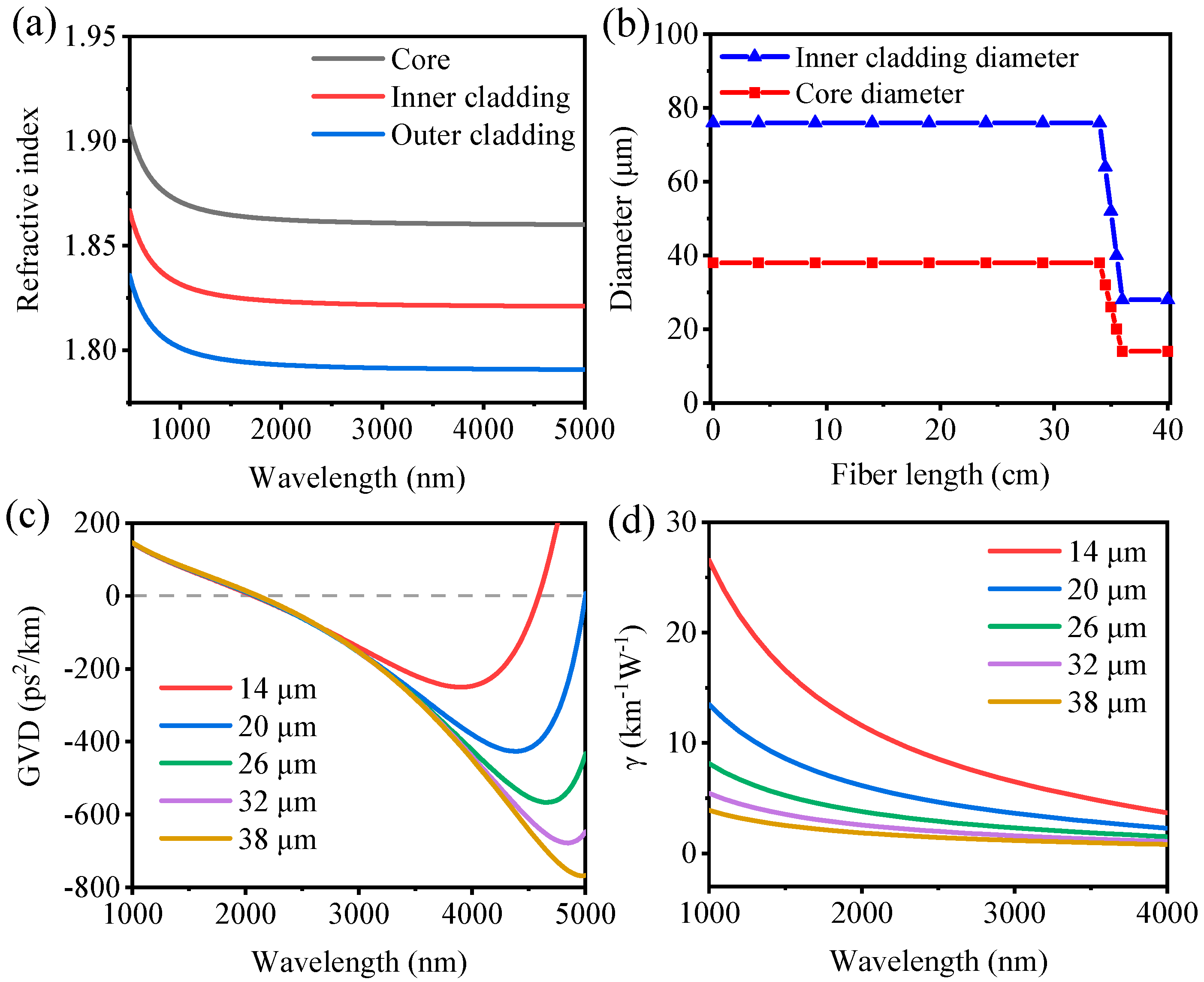

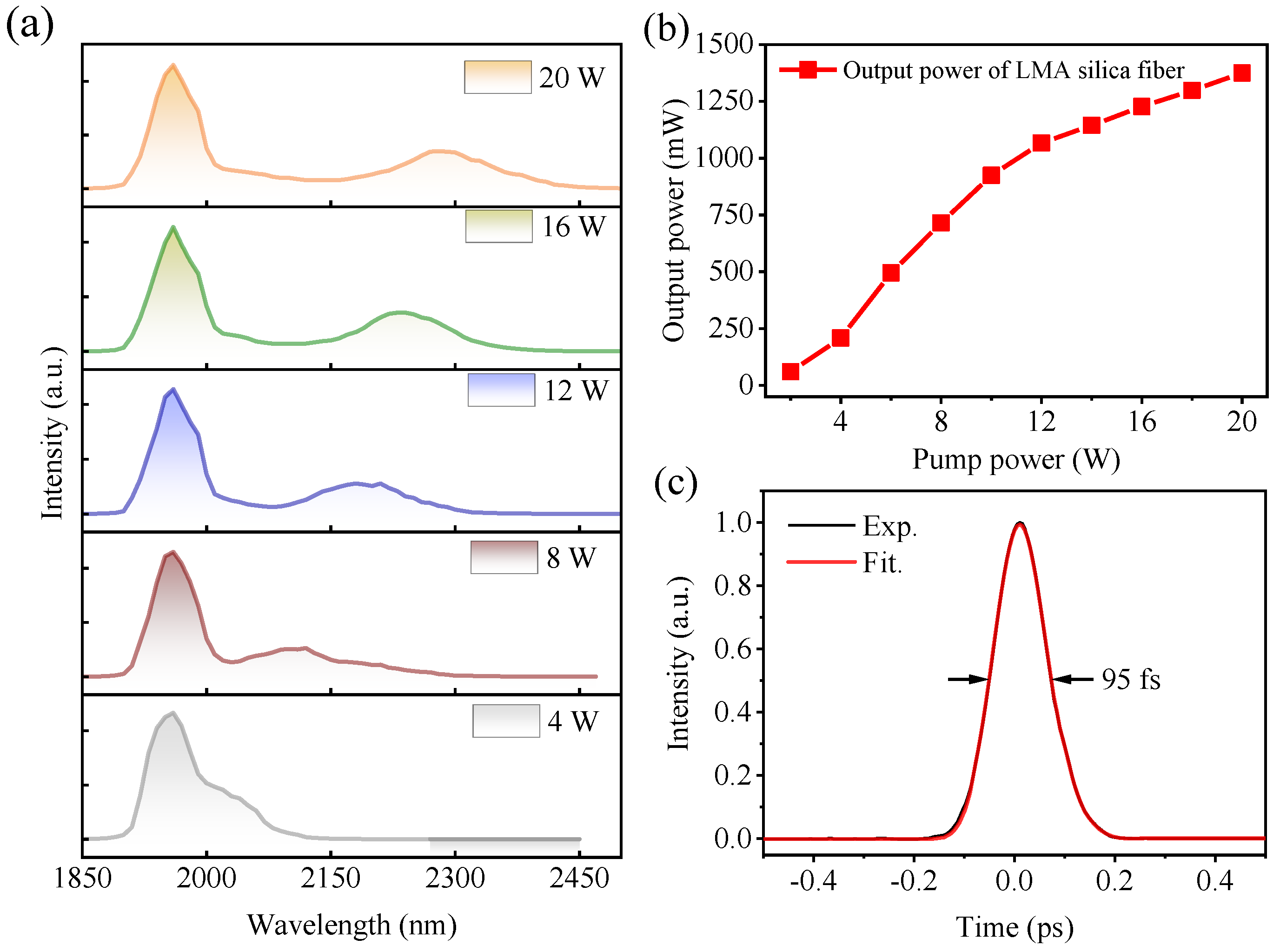
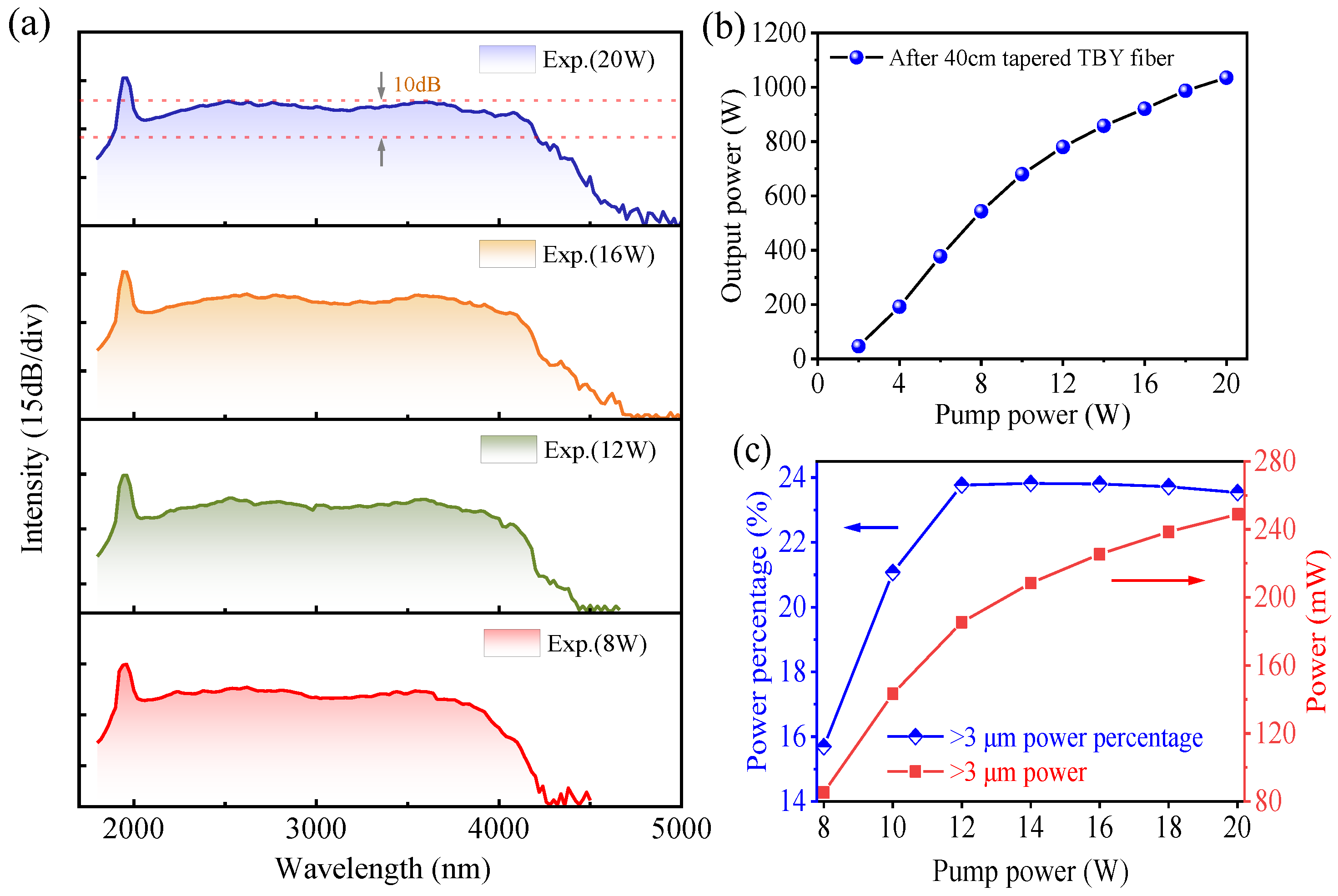
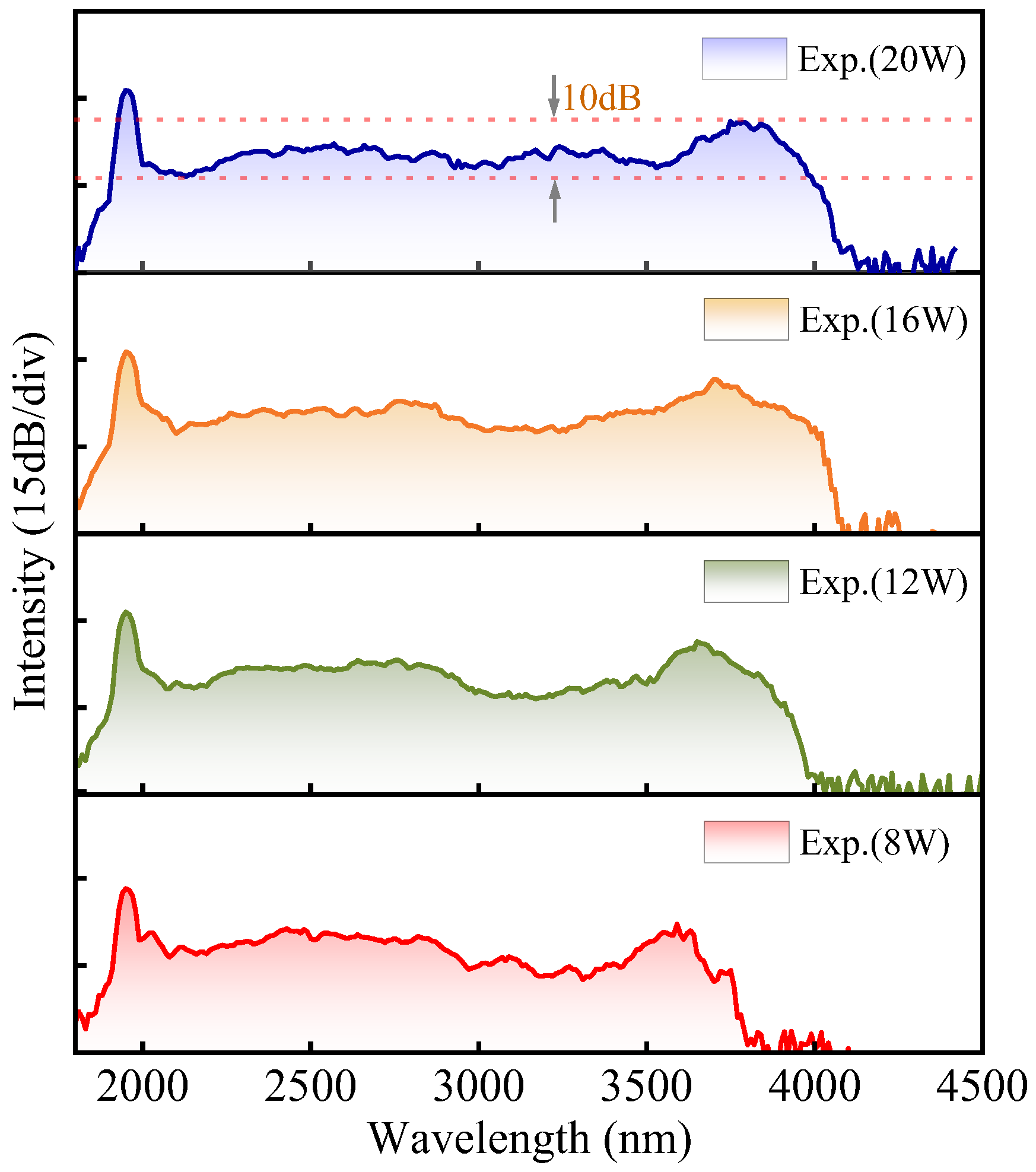
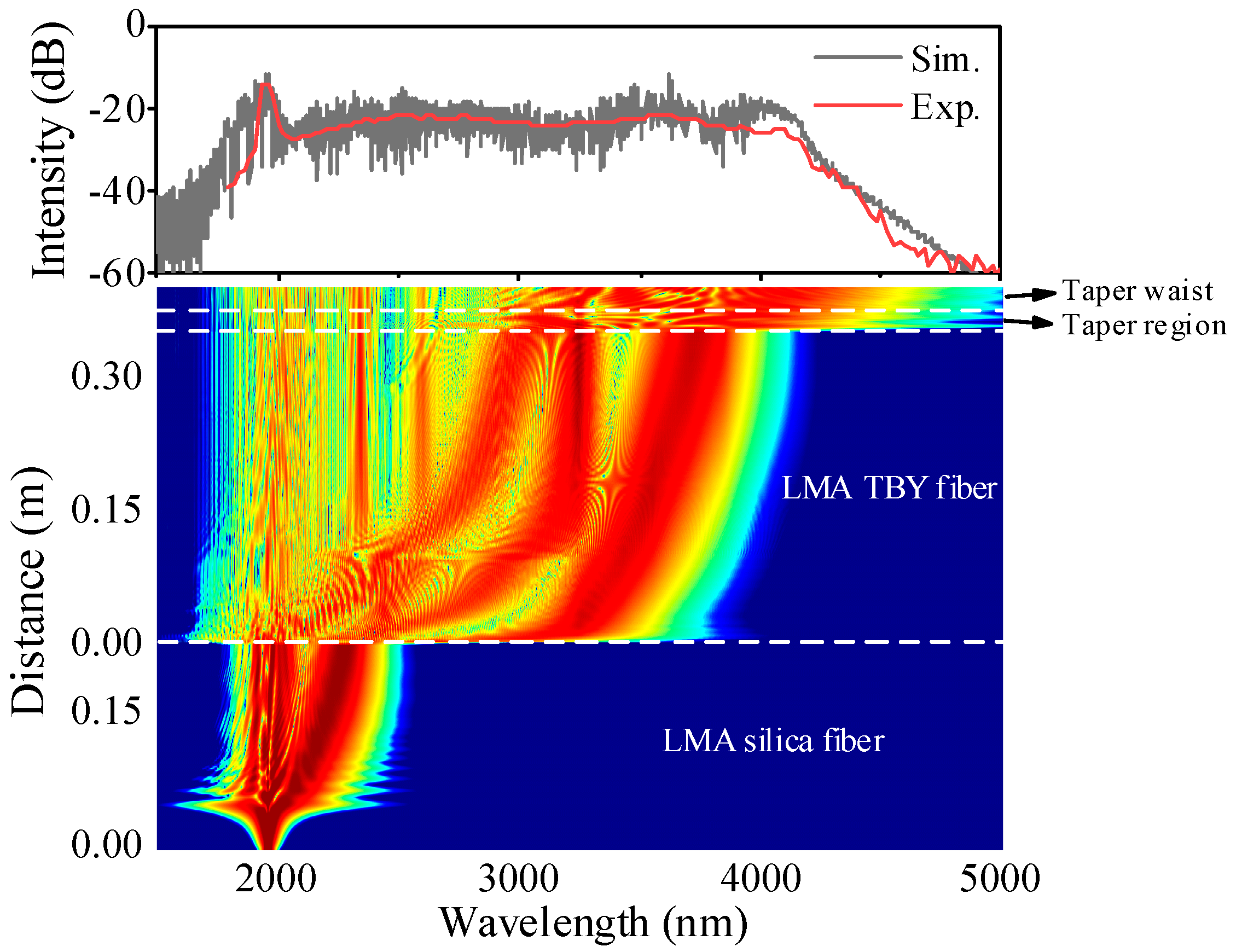
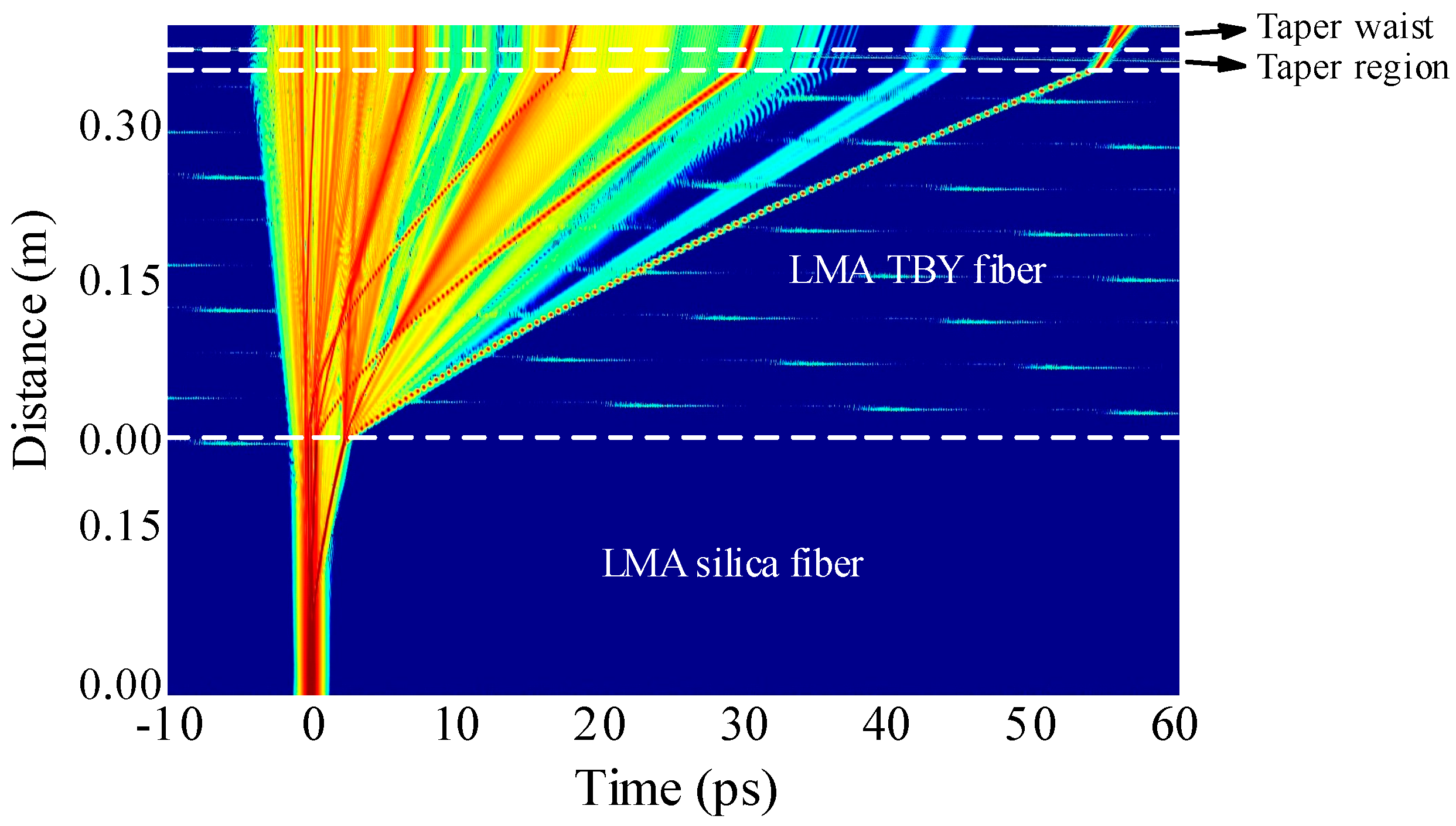
| Spectral Range (μm) | 10 dB Bandwidth Range (μm) | Power (W) | Optical-to-Optical Conversion Efficiency | Reference |
|---|---|---|---|---|
| 0.93–3.99 | 2–3.5 | 25.8 | 60.6% | [14] |
| 1.8–4.2 | 1.9–4.1 | 10.4 | 74% | [24] |
| 1.22–3.74 | 1.4–3.25 | 50 | 68.47% | [23] |
| 0.93–3.95 | 1.89–3.52 | 22.7 | 57.2% | [13] |
| 0.95–3.93 | 1.9–3 | 10.4 | 65% | [22] |
| 1.02–3.44 | 1.8–3.3 | 4.5 | 42.9% | [21] |
| 1.8–4.75 | 1.88–4.22 | 1.04 | 75% | This work |
Disclaimer/Publisher’s Note: The statements, opinions and data contained in all publications are solely those of the individual author(s) and contributor(s) and not of MDPI and/or the editor(s). MDPI and/or the editor(s) disclaim responsibility for any injury to people or property resulting from any ideas, methods, instructions or products referred to in the content. |
© 2025 by the authors. Licensee MDPI, Basel, Switzerland. This article is an open access article distributed under the terms and conditions of the Creative Commons Attribution (CC BY) license (https://creativecommons.org/licenses/by/4.0/).
Share and Cite
Ren, G.; Yang, L.; Yao, C.; Wang, X.; Pu, L.; Li, K.; Zhang, L.; Li, P. Mid-Infrared Ultraflat Broadband Supercontinuum Generation with 10 dB Bandwidth of 2340 nm in a Tapered Fluorotellurite Fiber. Photonics 2025, 12, 297. https://doi.org/10.3390/photonics12040297
Ren G, Yang L, Yao C, Wang X, Pu L, Li K, Zhang L, Li P. Mid-Infrared Ultraflat Broadband Supercontinuum Generation with 10 dB Bandwidth of 2340 nm in a Tapered Fluorotellurite Fiber. Photonics. 2025; 12(4):297. https://doi.org/10.3390/photonics12040297
Chicago/Turabian StyleRen, Guochuan, Linjing Yang, Chuanfei Yao, Xuan Wang, Luyao Pu, Kaihang Li, Ling Zhang, and Pingxue Li. 2025. "Mid-Infrared Ultraflat Broadband Supercontinuum Generation with 10 dB Bandwidth of 2340 nm in a Tapered Fluorotellurite Fiber" Photonics 12, no. 4: 297. https://doi.org/10.3390/photonics12040297
APA StyleRen, G., Yang, L., Yao, C., Wang, X., Pu, L., Li, K., Zhang, L., & Li, P. (2025). Mid-Infrared Ultraflat Broadband Supercontinuum Generation with 10 dB Bandwidth of 2340 nm in a Tapered Fluorotellurite Fiber. Photonics, 12(4), 297. https://doi.org/10.3390/photonics12040297





